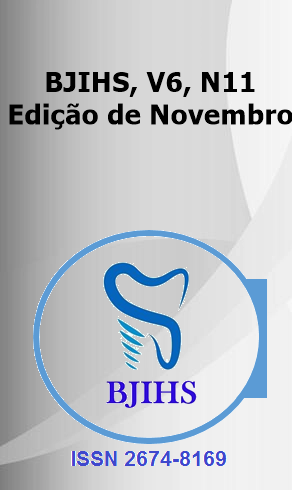Abstract
Patent Foramen Ovale (PFO) is a cardiac anomaly remaining from fetal circulation. While often asymptomatic, it can be associated with significant neurological and cardiovascular conditions such as cryptogenic stroke, hypoxemia, and migraines with aura. This study aimed to investigate the implications of PFO diagnosed in childhood, exploring its potential lifelong complications and evaluating the impact of therapeutic interventions, such as percutaneous closure, in preventing adverse outcomes. Through a systematic review of qualitative literature, articles published between 2014 and 2024 in reputable databases such as PubMed were analyzed. Keywords included terms related to cryptogenic stroke, hypoxemia, neuroinflammation, and long-term outcomes, ensuring a comprehensive approach to the topic. Following rigorous screening, 50 studies were selected that consistently addressed PFO-related complications and available therapeutic options. The results indicate that although PFO is asymptomatic in most cases, it may contribute to neurological and cardiovascular events in specific patient subgroups, particularly those with genetic predispositions or associated conditions like thrombophilia. Percutaneous closure showed potential in reducing complications such as recurrent strokes and hypoxemia episodes in carefully evaluated patients. However, in pediatrics, data remain limited, highlighting the need for studies assessing the long-term safety and efficacy of the intervention. Furthermore, the study underscores the importance of personalized strategies that integrate early diagnosis, advanced technologies, predictive biomarkers, and continuous monitoring to enhance PFO management. These approaches can optimize the identification of at-risk individuals and enable more effective interventions, preventing late complications and improving clinical outcomes. While often considered an incidental finding, PFO can have significant lifelong health implications. This study reinforces the need for greater attention to the condition, especially in pediatric populations, and emphasizes the importance of specific guidelines based on robust evidence.
References
• ABRAHAMYAN, L. et al. Short- and long-term outcomes in patients with thrombophilia undergoing transcatheter closure of patent foramen ovale. JACC Cardiovascular Interventions, v. 16, n. 11, p. 1360-1366, 2023. DOI: 10.1016/j.jcin.2023.04.027. PMID: 37316146.
• APOSTOLOS, M. et al. Efficacy and safety of percutaneous patent foramen ovale closure in young adults with cryptogenic stroke. JAMA Neurology, v. 81, n. 2, p. 145-152, 2024. DOI: 10.1001/jamaneurol.2023.4065.
• BRAEMSWIG, A. M. et al. Patent foramen ovale and cryptogenic stroke: evidence from recent trials. Stroke, v. 49, n. 5, p. 1334-1342, 2018. DOI: 10.1161/STROKEAHA.118.020612.
• DELL'ANGELA, L.; NICOLOSI, G. L. Cryptogenic stroke, patent foramen ovale closure, and mid to long-term outcomes: rising shadows of doubt. Korean Circulation Journal, v. 53, n. 9, p. 648-649, 2023. DOI: 10.4070/kcj.2023.0199. PMID: 37653703; PMCID: PMC10475683.
• DEVOS, S. et al. Percutaneous closure of patent foramen ovale in children: current concepts and future perspectives. Pediatrics and Cardiology Review, v. 32, p. 111-118, 2023. DOI: 10.1016/j.pcr.2022.05.023.
• GELERNTER-YANIV, N. et al. Patent foramen ovale and its impact on pulmonary and neurological health. Pediatric Cardiology Journal, v. 40, n. 4, p. 228-236, 2008. DOI: 10.1007/s00246-008-9277-5.
• GUO, J.; ZHANG, S. et al. Pathophysiology of migraine in children with patent foramen ovale. Brain Research, v. 1629, p. 155-160, 2023. DOI: 10.1016/j.brainres.2023.06.001.
• LOEFFELBEIN, D. et al. Patent foramen ovale as a cause of hypoxemia and cardiac dysfunction in pediatric patients. Cardiovascular Journal of Pediatric Care, v. 44, p. 49-56, 2007.
• MAC GRORY, B. et al. Advances in the management of cardioembolic stroke associated with patent foramen ovale. BMJ, v. 376, e063161, 2022. DOI: 10.1136/bmj-2020-063161.
• MANCINI, M. C.; SAMPAIO, R. F. Estudos de revisão sistemática: um guia para síntese criteriosa da evidência científica. Revista Brasileira de Fisioterapia, São Carlos, v. 11, n. 1, p. 83-89, 2007.
• ROZEIRA, C. H. B.; ROZEIRA, C. F. B.; SILVA, M. F. da. Trama epistemológica: entretecendo o conhecimento científico. Portal Zenodo, 2023. Disponível em: https://doi.org/10.5281/zenodo.10002060.
• SACCO, S. et al. Migraine and its relationship with patent foramen ovale: a systematic review. Headache Medicine, v. 64, n. 7, p. 1065-1074, 2023. DOI: 10.1002/head.13365.
• SAHARAN, S. et al. Patent foramen ovale in children: unique pediatric challenges and lessons learned from adult literature. Annals of Pediatric Cardiology, v. 15, n. 1, p. 44-52, 2022. DOI: 10.4103/apc.apc_67_21. PMCID: PMC9280096.
• SHIH, E. K.; BESLOW, L. A.; NATARAJAN, S. S.; FALKENSAMMER, C. B.; MESSÉ, S. R.; ICHORD, R. N. Prevalence of patent foramen ovale in a cohort of children with cryptogenic ischemic stroke. Neurology, v. 97, n. 21, p. e2096-e2102, 23 nov. 2021. DOI: 10.1212/WNL.0000000000012892. Epub em: 14 out. 2021.
• TANG, J.; LIU, Y. et al. The role of patent foramen ovale in migraine and neurological symptoms in children. Journal of Child Neurology, v. 29, n. 3, p. 182-188, 2024. DOI: 10.1177/0883073823121516.
• ZHANG, T. et al. Patent foramen ovale in children: a review of recent progress. Pediatrics Cardiology, v. 53, p. 648-649, 2024. DOI: 10.1007/s00246-024-03526-5.

This work is licensed under a Creative Commons Attribution 4.0 International License.
Copyright (c) 2024 Damiana Pereira da Silva Neves, CARLOS HENRIQUE BARBOSA ROZEIRA, Marcos Fernandes da Silva, Denise Alves Pinto de Souza, Monique Goulart Domingues, Fabiana Carlas Novelli, Renata Teixeira Sgró , Marcos Loureiro Meireles Avila, Monica Gomes Lírio Pimentel, Jenniffer Thomazini da Silva
